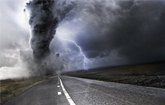
More Than $12 Trillion in U.S. Homes Face Severe Climate Risks, New Realtor.com® Analysis Finds
26% of U.S. homes are vulnerable to flooding, wildfire, or hurricane wind damage resulting in higher insurance premiums
AUSTIN, Texas, Sept. 3, 2025 /PRNewswire/ -- More than one in four homes in the U.S.—representing $12.7 trillion in real estate value—are exposed to severe or extreme climate risks, according to a Realtor.com® report released today. The report highlights how flood, hurricane wind, and wildfire threats are reshaping housing markets, homeowner costs, and insurance availability nationwide.
"Climate risks are no longer a distant threat for U.S. housing—they are a present reality that put a large chunk of U.S. real estate value at risk," said Danielle Hale, Chief Economist at Realtor.com®. "In many markets, the gap between perceived risk and actual risk is sizable, particularly for flooding. This has significant consequences for homeowners, buyers, and insurers, and it underscores the need for readily available data to help households make informed decisions."
Flood Risk: Underestimated and Growing
Flood risk is one of the most underestimated hazards in the housing market. Nearly 6 million homes, valued at $3.4 trillion, are likely to experience severe or extreme flooding over the next 30 years, according to First Street's Flood Factor score data found on Realtor.com®. This figure is about 2 million higher than the number of homes located in FEMA's Special Flood Hazard Areas (SFHAs), largely because FEMA's maps do not fully reflect heavy rainfall or the effects of climate change.
Within the 100 largest metros, New York, Los Angeles and San Francisco are the top metros where we see the biggest gap in dollar terms, between homes in FEMA SFHAs and homes facing severe or extreme flood risk, by $95.3 billion (New York), $65.6 billion (Los Angeles) and $54.9 billion (San Francisco). By gap in share of market value, New Orleans leads the nation with 66 percentage points of its housing stock at severe or extreme flood risk but not identified by FEMA SFHAs, followed by Palm Bay, Florida, at 15 percentage points and Chattanooga, Tennessee, at 11 percentage points.
Coastal markets dominate the list of metro areas with the greatest dollar value and share of dollar value exposed to severe or extreme flood risk.
Table 1 A: Metro Ranked by Total Value of Homes With Severe or Extreme Flood Risk (Flood Factor Score>=7)
Rank |
Metros |
Total Value |
Share of Value |
1 |
Miami-Fort Lauderdale-West Palm Beach, FL |
$306.8B |
23.2 % |
2 |
New York-Newark-Jersey City, NY-NJ |
$295.3B |
9.9 % |
3 |
Tampa-St. Petersburg-Clearwater, FL |
$117.7B |
25.6 % |
4 |
Los Angeles-Long Beach-Anaheim, CA |
$99.6B |
3.2 % |
5 |
Houston-Pasadena-The Woodlands, TX |
$92.4B |
12.1 % |
Table 1 B: Metro Ranked by Share of Value of Homes With Severe or Extreme Flood Risk (Flood Factor Score>=7)
Rank |
Metros |
Share of Value |
Total Value |
1 |
New Orleans-Metairie, LA |
88.9 % |
$72.1B |
2 |
Cape Coral-Fort Myers, FL |
46.1 % |
$77.5B |
3 |
Charleston-North Charleston, SC |
34.7 % |
$59.8B |
4 |
North Port-Bradenton-Sarasota, FL |
29.3 % |
$59.7B |
5 |
Tampa-St. Petersburg-Clearwater, FL |
25.6 % |
$117.7B |
Hurricane Wind Risk: Entire Markets at Stake
In 2025, approximately 18.3% of homes in the United States, valued at nearly $8.0 trillion, face severe or extreme risk of wind damage, according to First Street's Wind Factor score data available on Realtor.com. In fourteen major metros across Louisiana, Florida, South Carolina, and Texas—including Miami, Houston, Tampa, and New Orleans—every home is exposed to severe or extreme risk of wind damage. Because these risks frequently overlap with flood exposure, homeowners in coastal markets face compounded threats. Financially, the burden is amplified by high hurricane deductibles; in many states, homeowners with a $400,000 policy may need to cover as much as $20,000 in damage before insurance kicks in.
Table 2 A: Metro Ranked by Total Value at Severe or Extreme Wind Risk (Wind Factor Score>=7)
Rank |
Metros |
Total Value |
Share of Value |
1 |
Miami-Fort Lauderdale-West Palm Beach, FL |
$1,323.9B |
100.0 % |
2 |
Houston-Pasadena-The Woodlands, TX |
$764.3B |
100.0 % |
3 |
New York-Newark-Jersey City, NY-NJ |
$545.6B |
18.3 % |
4 |
Tampa-St. Petersburg-Clearwater, FL |
$459.7B |
100.0 % |
5 |
Orlando-Kissimmee-Sanford, FL |
$372.2B |
100.0 % |
Table 2 B: Metros where All Homes Face Severe or Extreme Wind Risk (Wind Factor Score >=7)
Rank |
Metros |
Share of Value |
Total Value |
1 |
Baton Rouge, LA |
100.0 % |
$70.1B |
2 |
Cape Coral-Fort Myers, FL |
100.0 % |
$168.0B |
3 |
Charleston-North Charleston, SC |
100.0 % |
$172.6B |
4 |
Deltona-Daytona Beach-Ormond Beach, FL |
100.0 % |
$103.1B |
5 |
Houston-Pasadena-The Woodlands, TX |
100.0 % |
$764.3B |
6 |
Jacksonville, FL |
100.0 % |
$240.1B |
7 |
Lakeland-Winter Haven, FL |
100.0 % |
$73.9B |
8 |
McAllen-Edinburg-Mission, TX |
100.0 % |
$41.3B |
9 |
Miami-Fort Lauderdale-West Palm Beach, FL |
100.0 % |
$1,323.9B |
10 |
New Orleans-Metairie, LA |
100.0 % |
$81.0B |
11 |
North Port-Bradenton-Sarasota, FL |
100.0 % |
$203.0B |
12 |
Orlando-Kissimmee-Sanford, FL |
100.0 % |
$372.2B |
13 |
Palm Bay-Melbourne-Titusville, FL |
100.0 % |
$98.2B |
14 |
Tampa-St. Petersburg-Clearwater, FL |
100.0 % |
$459.7B |
Wildfire Risk: Concentrated but Intensifying
Wildfire exposure, while geographically concentrated, represents a significant and growing challenge. In 2025, 5.6 percent of homes, worth $3.2 trillion, face severe or extreme wildfire risk, according to First Street Fire Factor score data available on Realtor.com. California alone accounts for nearly 40 percent of this total, or $1.8 trillion in property value, with Los Angeles and Riverside among the most exposed metros. The state's insurance market is under severe stress: California's FAIR Plan, designed as a last-resort option, has grown to $650 billion in total exposure, up 289 percent since 2021.
Outside California, wildfire risk is also acute in western metros such as Colorado Springs, where more than three-quarters of home value is vulnerable, and Tucson, where 60 percent of housing stock faces high fire danger.
Insurance Costs: Rising and Uneven
Rising insurance costs are amplifying the financial strain on homeowners in these high-risk areas. In Miami, for single-family homeowners under a HO-3 policy, the most common type of homeowners insurance policy in the U.S., the typical homeowner now pays annual premiums equal to 3.7 percent of the home's market value—the highest ratio among the nation's 100 largest metros.
New Orleans follows closely at 3.6 percent, with Cape Coral, Florida, at 2.2 percent. Florida cities dominate the list of expensive insurance markets, with Tampa, Palm Bay, and North Port all ranking among the top ten. These burdens come on top of structural gaps in coverage: flood insurance is typically sold separately, hurricane deductibles are significantly higher than standard policies, and wildfire coverage in many regions is either limited or unaffordable
"Climate risk and insurance are not usually a top consideration for home shoppers balancing budgets against still-high home prices and mortgage rates, but these factors already shape ongoing housing costs and affordability, and increasingly whether they can secure affordable insurance coverage," said Hale. "While the types of risk vary by region—flooding in the Northeast, wildfires in the West, and hurricanes in the South—the financial consequences are increasingly national in scope."
Table 3: Markets with the Highest Insurance Burden
Rank |
Market |
Median |
Median Market |
Estimated |
||||
1 |
Miami-Fort Lauderdale-West Palm Beach, FL |
3.7 % |
$614,000 |
$22,718 |
||||
2 |
New Orleans-Metairie, LA |
3.6 % |
$231,328 |
$8,328 |
||||
3 |
Cape Coral-Fort Myers, FL |
2.2 % |
$393,147 |
$8,649 |
||||
4 |
Oklahoma City, OK |
2.0 % |
$236,889 |
$4,738 |
||||
5 |
Baton Rouge, LA |
2.0 % |
$233,600 |
$4,672 |
||||
6 |
Palm Bay-Melbourne-Titusville, FL |
1.7 % |
$363,076 |
$6,172 |
||||
7 |
North Port-Bradenton-Sarasota, FL |
1.7 % |
$450,401 |
$7,657 |
||||
8 |
Tulsa, OK |
1.7 % |
$230,530 |
$3,919 |
||||
9 |
Tampa-St. Petersburg-Clearwater, FL |
1.7 % |
$390,900 |
$6,645 |
||||
10 |
Houston-Pasadena-The Woodlands, TX |
1.5 % |
$317,000 |
$4,755 |
||||
Top 100 Average |
0.8 % |
$435,633 |
$3,485 |
|||||
Note: Realtor.com leveraged rate data from Insurify, a digital insurance agency and comparison platform, to calculate the home insurance prices used in this report. Rates in this table represent the median annual cost of a HO-3 insurance policy for homeowners with good credit and zero claims within the past five years, covering a single- family frame house with the following coverage limits: variable dwelling coverage appropriate for the home value, personal property coverage at 75% of dwelling coverage limit, $300,000 liability, a $1,000 deductible general deductible and a 2% hail deductible, a 5% wind/hurricane deductible.
|
||||||||
Methodology
Realtor.com leveraged insurance data from Insurify, a digital insurance agency and comparison platform, to calculate home insurance rates used in this report.
The analysis is based on the median annual cost of a HO-3 insurance policy for homeowners with good credit and no claims in the past five years. Policy assumptions include coverage for a single-family frame home with variable dwelling coverage appropriate for the home value, personal property coverage at 75% of dwelling coverage limit, $300,000 liability, a $1,000 general deductible and a 2% hail deductible, a 5% wind/hurricane deductible.
Since the insurance rates were originally provided at the county level, we applied property-level insurance modifiers from Insurify to detailed property features on Realtor.com to generate more accurate premium estimates for individual properties. Additionally, each property was matched with the most recent Automated Valuation Model (AVM) estimates provided by Realtor.com® data providers to determine market values, which were then used to calculate the insurance premium-to-market-value ratio and aggregate metro-level median ratios.
Severe and extreme risk refers to homes with a fire, flood and wind Factor Score of 7 or higher from First Street. Each Factor Score boundaries were overlaid on top of Realtor.com® single family, condo, townhome, rowhome and co-op property data to assign a score to each home which was matched to the most recent Automated Valuation Model (AVM) estimates from Realtor.com® data providers to derive values. Urban Honolulu, HI is not included in the top 100 metro rankings due to lack of data available for some risk types.
About Realtor.com®
Realtor.com® pioneered online real estate and has been at the forefront for over 25 years, connecting buyers, sellers, and renters with trusted insights, professional guidance and powerful tools to help them find their perfect home. Recognized as the No. 1 site trusted by real estate professionals, Realtor.com® is a valued partner, delivering consumer connections and a robust suite of marketing tools to support business growth. Realtor.com® is operated by News Corp [Nasdaq: NWS, NWSA] [ASX: NWS, NWSLV] subsidiary Move, Inc.
Media contact: Mallory Micetich, [email protected]
SOURCE Realtor.com






Share this article